Social E-Commerce: Opportunities & Problems
VerifiedAdded on 2020/03/02
|11
|3385
|207
Literature Review
AI Summary
This literature review examines the opportunities and challenges presented by social e-commerce. It explores how businesses utilize social media platforms like Facebook, Instagram, Pinterest, and Twitter to engage customers and drive sales. The review highlights the potential for increased brand awareness, targeted marketing, and enhanced customer relationships. However, it also addresses the challenges of managing brand reputation, navigating global versus local strategies, and dealing with high competition. The review concludes by suggesting strategic actions for businesses to effectively leverage social e-commerce, including developing a comprehensive strategy, building strong customer connections, and utilizing social analytics to understand customer needs and preferences. The paper draws upon various academic sources to support its analysis and provide a comprehensive overview of the topic.

RUNNING HEAD: Literature Review
Literature Review
Opportunities and Problems of Social Electronic Commerce
Literature Review
Opportunities and Problems of Social Electronic Commerce
Paraphrase This Document
Need a fresh take? Get an instant paraphrase of this document with our AI Paraphraser

Opportunities and Problems of Social Electronic Commerce 1
Table of Contents
Introduction...........................................................................................................................................2
Project Scope.........................................................................................................................................2
Project Objective...................................................................................................................................2
Literature Review..................................................................................................................................2
Conclusion.............................................................................................................................................7
References.............................................................................................................................................9
Table of Contents
Introduction...........................................................................................................................................2
Project Scope.........................................................................................................................................2
Project Objective...................................................................................................................................2
Literature Review..................................................................................................................................2
Conclusion.............................................................................................................................................7
References.............................................................................................................................................9
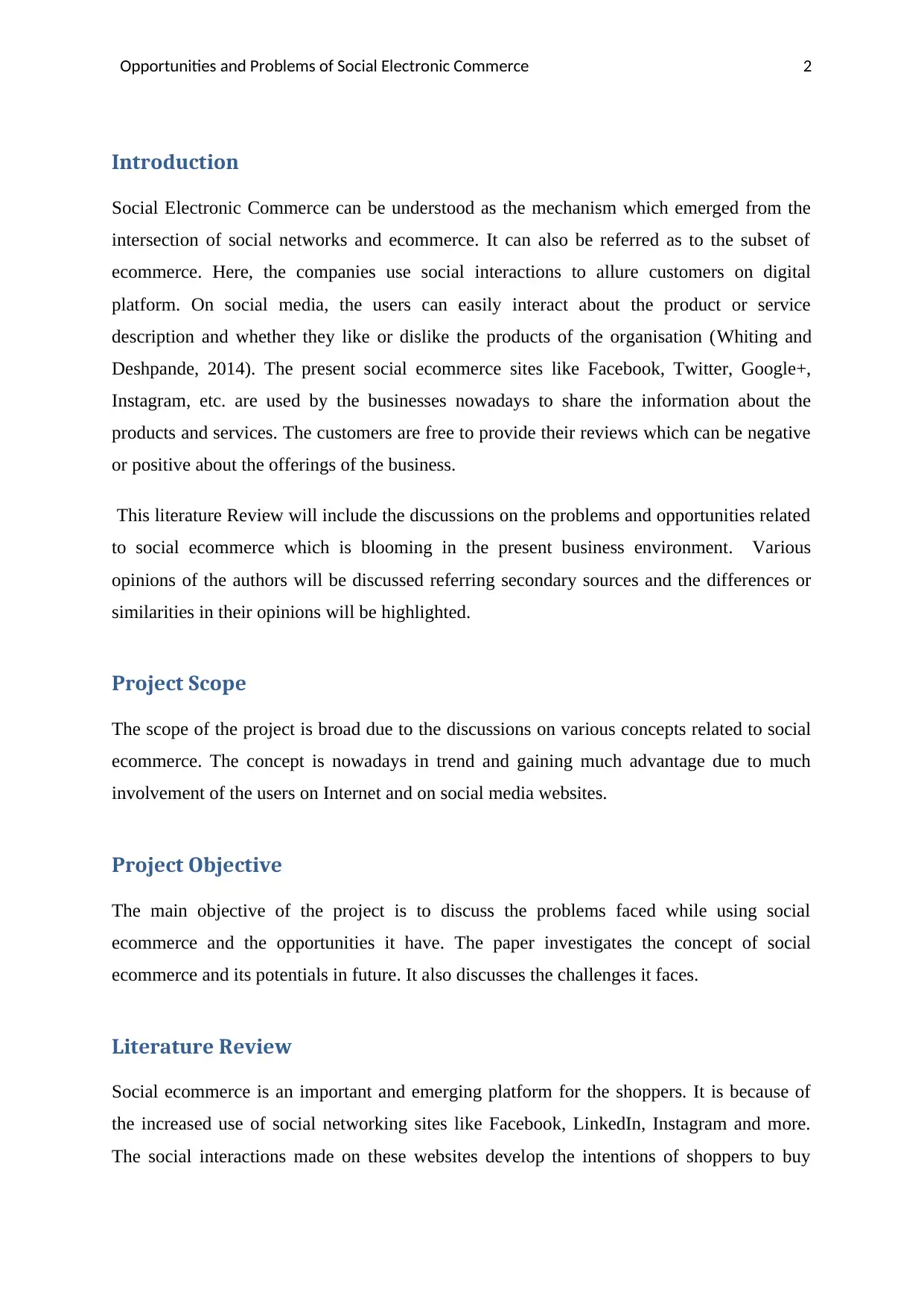
Opportunities and Problems of Social Electronic Commerce 2
Introduction
Social Electronic Commerce can be understood as the mechanism which emerged from the
intersection of social networks and ecommerce. It can also be referred as to the subset of
ecommerce. Here, the companies use social interactions to allure customers on digital
platform. On social media, the users can easily interact about the product or service
description and whether they like or dislike the products of the organisation (Whiting and
Deshpande, 2014). The present social ecommerce sites like Facebook, Twitter, Google+,
Instagram, etc. are used by the businesses nowadays to share the information about the
products and services. The customers are free to provide their reviews which can be negative
or positive about the offerings of the business.
This literature Review will include the discussions on the problems and opportunities related
to social ecommerce which is blooming in the present business environment. Various
opinions of the authors will be discussed referring secondary sources and the differences or
similarities in their opinions will be highlighted.
Project Scope
The scope of the project is broad due to the discussions on various concepts related to social
ecommerce. The concept is nowadays in trend and gaining much advantage due to much
involvement of the users on Internet and on social media websites.
Project Objective
The main objective of the project is to discuss the problems faced while using social
ecommerce and the opportunities it have. The paper investigates the concept of social
ecommerce and its potentials in future. It also discusses the challenges it faces.
Literature Review
Social ecommerce is an important and emerging platform for the shoppers. It is because of
the increased use of social networking sites like Facebook, LinkedIn, Instagram and more.
The social interactions made on these websites develop the intentions of shoppers to buy
Introduction
Social Electronic Commerce can be understood as the mechanism which emerged from the
intersection of social networks and ecommerce. It can also be referred as to the subset of
ecommerce. Here, the companies use social interactions to allure customers on digital
platform. On social media, the users can easily interact about the product or service
description and whether they like or dislike the products of the organisation (Whiting and
Deshpande, 2014). The present social ecommerce sites like Facebook, Twitter, Google+,
Instagram, etc. are used by the businesses nowadays to share the information about the
products and services. The customers are free to provide their reviews which can be negative
or positive about the offerings of the business.
This literature Review will include the discussions on the problems and opportunities related
to social ecommerce which is blooming in the present business environment. Various
opinions of the authors will be discussed referring secondary sources and the differences or
similarities in their opinions will be highlighted.
Project Scope
The scope of the project is broad due to the discussions on various concepts related to social
ecommerce. The concept is nowadays in trend and gaining much advantage due to much
involvement of the users on Internet and on social media websites.
Project Objective
The main objective of the project is to discuss the problems faced while using social
ecommerce and the opportunities it have. The paper investigates the concept of social
ecommerce and its potentials in future. It also discusses the challenges it faces.
Literature Review
Social ecommerce is an important and emerging platform for the shoppers. It is because of
the increased use of social networking sites like Facebook, LinkedIn, Instagram and more.
The social interactions made on these websites develop the intentions of shoppers to buy
⊘ This is a preview!⊘
Do you want full access?
Subscribe today to unlock all pages.

Trusted by 1+ million students worldwide
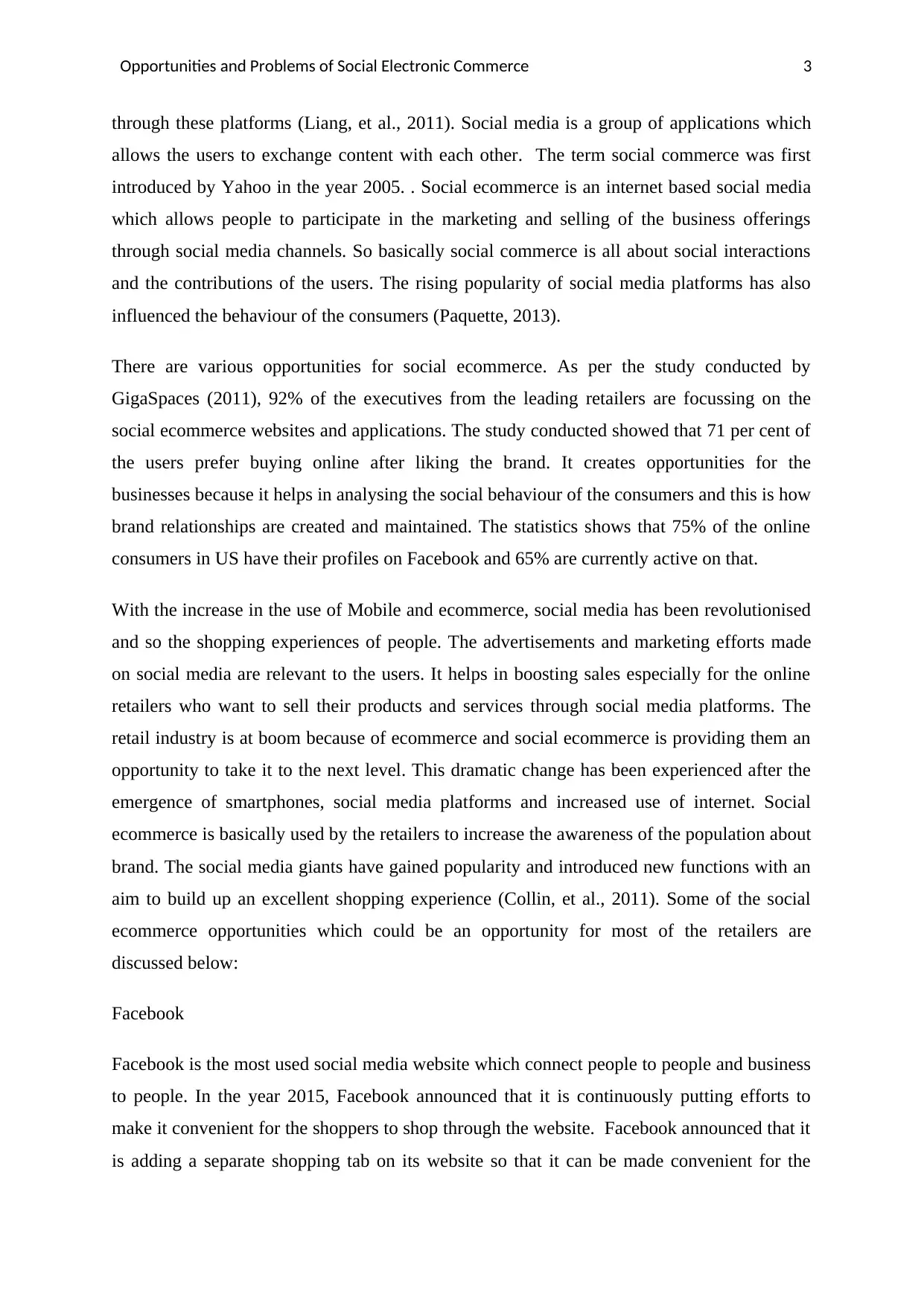
Opportunities and Problems of Social Electronic Commerce 3
through these platforms (Liang, et al., 2011). Social media is a group of applications which
allows the users to exchange content with each other. The term social commerce was first
introduced by Yahoo in the year 2005. . Social ecommerce is an internet based social media
which allows people to participate in the marketing and selling of the business offerings
through social media channels. So basically social commerce is all about social interactions
and the contributions of the users. The rising popularity of social media platforms has also
influenced the behaviour of the consumers (Paquette, 2013).
There are various opportunities for social ecommerce. As per the study conducted by
GigaSpaces (2011), 92% of the executives from the leading retailers are focussing on the
social ecommerce websites and applications. The study conducted showed that 71 per cent of
the users prefer buying online after liking the brand. It creates opportunities for the
businesses because it helps in analysing the social behaviour of the consumers and this is how
brand relationships are created and maintained. The statistics shows that 75% of the online
consumers in US have their profiles on Facebook and 65% are currently active on that.
With the increase in the use of Mobile and ecommerce, social media has been revolutionised
and so the shopping experiences of people. The advertisements and marketing efforts made
on social media are relevant to the users. It helps in boosting sales especially for the online
retailers who want to sell their products and services through social media platforms. The
retail industry is at boom because of ecommerce and social ecommerce is providing them an
opportunity to take it to the next level. This dramatic change has been experienced after the
emergence of smartphones, social media platforms and increased use of internet. Social
ecommerce is basically used by the retailers to increase the awareness of the population about
brand. The social media giants have gained popularity and introduced new functions with an
aim to build up an excellent shopping experience (Collin, et al., 2011). Some of the social
ecommerce opportunities which could be an opportunity for most of the retailers are
discussed below:
Facebook
Facebook is the most used social media website which connect people to people and business
to people. In the year 2015, Facebook announced that it is continuously putting efforts to
make it convenient for the shoppers to shop through the website. Facebook announced that it
is adding a separate shopping tab on its website so that it can be made convenient for the
through these platforms (Liang, et al., 2011). Social media is a group of applications which
allows the users to exchange content with each other. The term social commerce was first
introduced by Yahoo in the year 2005. . Social ecommerce is an internet based social media
which allows people to participate in the marketing and selling of the business offerings
through social media channels. So basically social commerce is all about social interactions
and the contributions of the users. The rising popularity of social media platforms has also
influenced the behaviour of the consumers (Paquette, 2013).
There are various opportunities for social ecommerce. As per the study conducted by
GigaSpaces (2011), 92% of the executives from the leading retailers are focussing on the
social ecommerce websites and applications. The study conducted showed that 71 per cent of
the users prefer buying online after liking the brand. It creates opportunities for the
businesses because it helps in analysing the social behaviour of the consumers and this is how
brand relationships are created and maintained. The statistics shows that 75% of the online
consumers in US have their profiles on Facebook and 65% are currently active on that.
With the increase in the use of Mobile and ecommerce, social media has been revolutionised
and so the shopping experiences of people. The advertisements and marketing efforts made
on social media are relevant to the users. It helps in boosting sales especially for the online
retailers who want to sell their products and services through social media platforms. The
retail industry is at boom because of ecommerce and social ecommerce is providing them an
opportunity to take it to the next level. This dramatic change has been experienced after the
emergence of smartphones, social media platforms and increased use of internet. Social
ecommerce is basically used by the retailers to increase the awareness of the population about
brand. The social media giants have gained popularity and introduced new functions with an
aim to build up an excellent shopping experience (Collin, et al., 2011). Some of the social
ecommerce opportunities which could be an opportunity for most of the retailers are
discussed below:
Facebook is the most used social media website which connect people to people and business
to people. In the year 2015, Facebook announced that it is continuously putting efforts to
make it convenient for the shoppers to shop through the website. Facebook announced that it
is adding a separate shopping tab on its website so that it can be made convenient for the
Paraphrase This Document
Need a fresh take? Get an instant paraphrase of this document with our AI Paraphraser
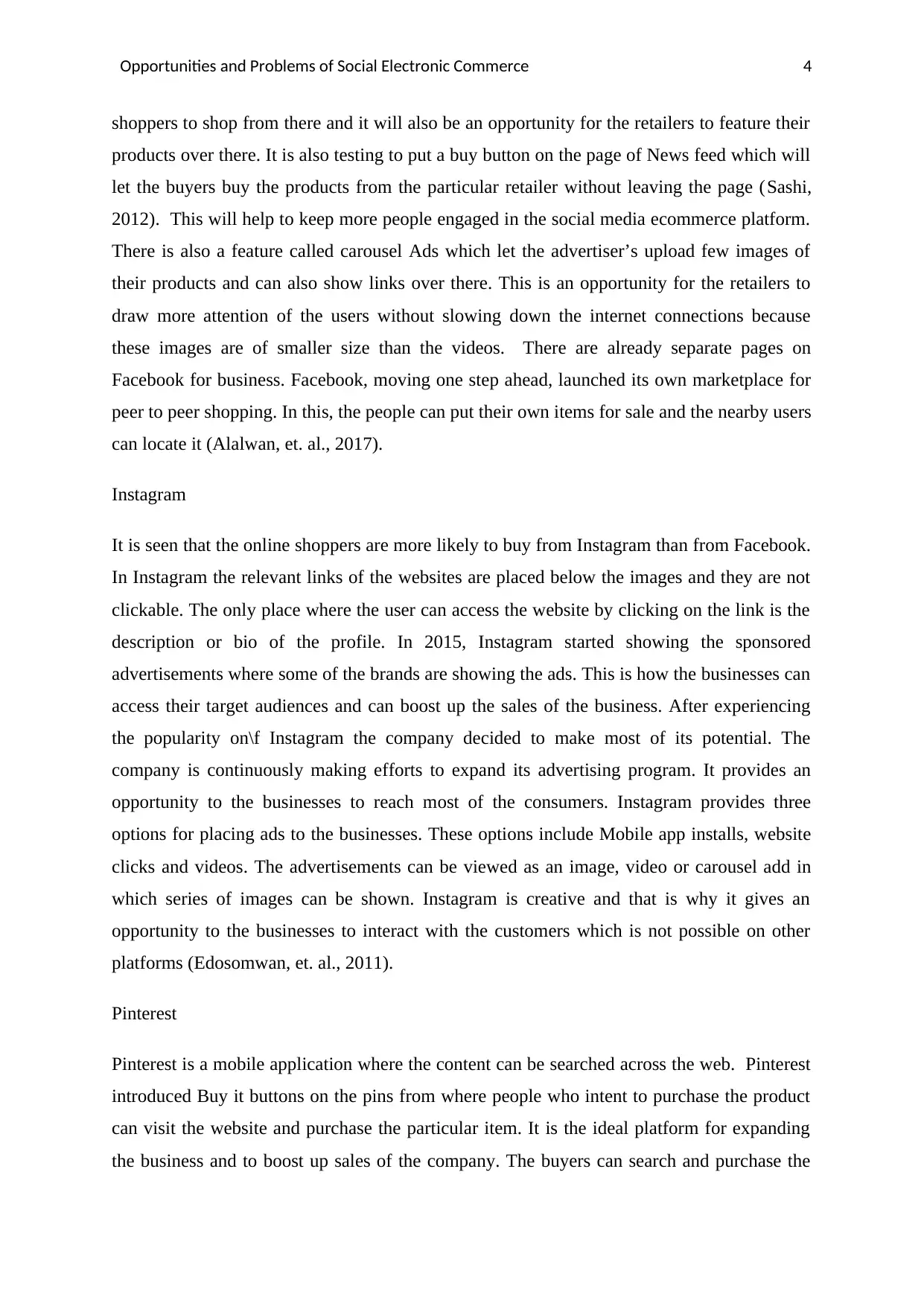
Opportunities and Problems of Social Electronic Commerce 4
shoppers to shop from there and it will also be an opportunity for the retailers to feature their
products over there. It is also testing to put a buy button on the page of News feed which will
let the buyers buy the products from the particular retailer without leaving the page (Sashi,
2012). This will help to keep more people engaged in the social media ecommerce platform.
There is also a feature called carousel Ads which let the advertiser’s upload few images of
their products and can also show links over there. This is an opportunity for the retailers to
draw more attention of the users without slowing down the internet connections because
these images are of smaller size than the videos. There are already separate pages on
Facebook for business. Facebook, moving one step ahead, launched its own marketplace for
peer to peer shopping. In this, the people can put their own items for sale and the nearby users
can locate it (Alalwan, et. al., 2017).
Instagram
It is seen that the online shoppers are more likely to buy from Instagram than from Facebook.
In Instagram the relevant links of the websites are placed below the images and they are not
clickable. The only place where the user can access the website by clicking on the link is the
description or bio of the profile. In 2015, Instagram started showing the sponsored
advertisements where some of the brands are showing the ads. This is how the businesses can
access their target audiences and can boost up the sales of the business. After experiencing
the popularity on\f Instagram the company decided to make most of its potential. The
company is continuously making efforts to expand its advertising program. It provides an
opportunity to the businesses to reach most of the consumers. Instagram provides three
options for placing ads to the businesses. These options include Mobile app installs, website
clicks and videos. The advertisements can be viewed as an image, video or carousel add in
which series of images can be shown. Instagram is creative and that is why it gives an
opportunity to the businesses to interact with the customers which is not possible on other
platforms (Edosomwan, et. al., 2011).
Pinterest
Pinterest is a mobile application where the content can be searched across the web. Pinterest
introduced Buy it buttons on the pins from where people who intent to purchase the product
can visit the website and purchase the particular item. It is the ideal platform for expanding
the business and to boost up sales of the company. The buyers can search and purchase the
shoppers to shop from there and it will also be an opportunity for the retailers to feature their
products over there. It is also testing to put a buy button on the page of News feed which will
let the buyers buy the products from the particular retailer without leaving the page (Sashi,
2012). This will help to keep more people engaged in the social media ecommerce platform.
There is also a feature called carousel Ads which let the advertiser’s upload few images of
their products and can also show links over there. This is an opportunity for the retailers to
draw more attention of the users without slowing down the internet connections because
these images are of smaller size than the videos. There are already separate pages on
Facebook for business. Facebook, moving one step ahead, launched its own marketplace for
peer to peer shopping. In this, the people can put their own items for sale and the nearby users
can locate it (Alalwan, et. al., 2017).
It is seen that the online shoppers are more likely to buy from Instagram than from Facebook.
In Instagram the relevant links of the websites are placed below the images and they are not
clickable. The only place where the user can access the website by clicking on the link is the
description or bio of the profile. In 2015, Instagram started showing the sponsored
advertisements where some of the brands are showing the ads. This is how the businesses can
access their target audiences and can boost up the sales of the business. After experiencing
the popularity on\f Instagram the company decided to make most of its potential. The
company is continuously making efforts to expand its advertising program. It provides an
opportunity to the businesses to reach most of the consumers. Instagram provides three
options for placing ads to the businesses. These options include Mobile app installs, website
clicks and videos. The advertisements can be viewed as an image, video or carousel add in
which series of images can be shown. Instagram is creative and that is why it gives an
opportunity to the businesses to interact with the customers which is not possible on other
platforms (Edosomwan, et. al., 2011).
Pinterest is a mobile application where the content can be searched across the web. Pinterest
introduced Buy it buttons on the pins from where people who intent to purchase the product
can visit the website and purchase the particular item. It is the ideal platform for expanding
the business and to boost up sales of the company. The buyers can search and purchase the
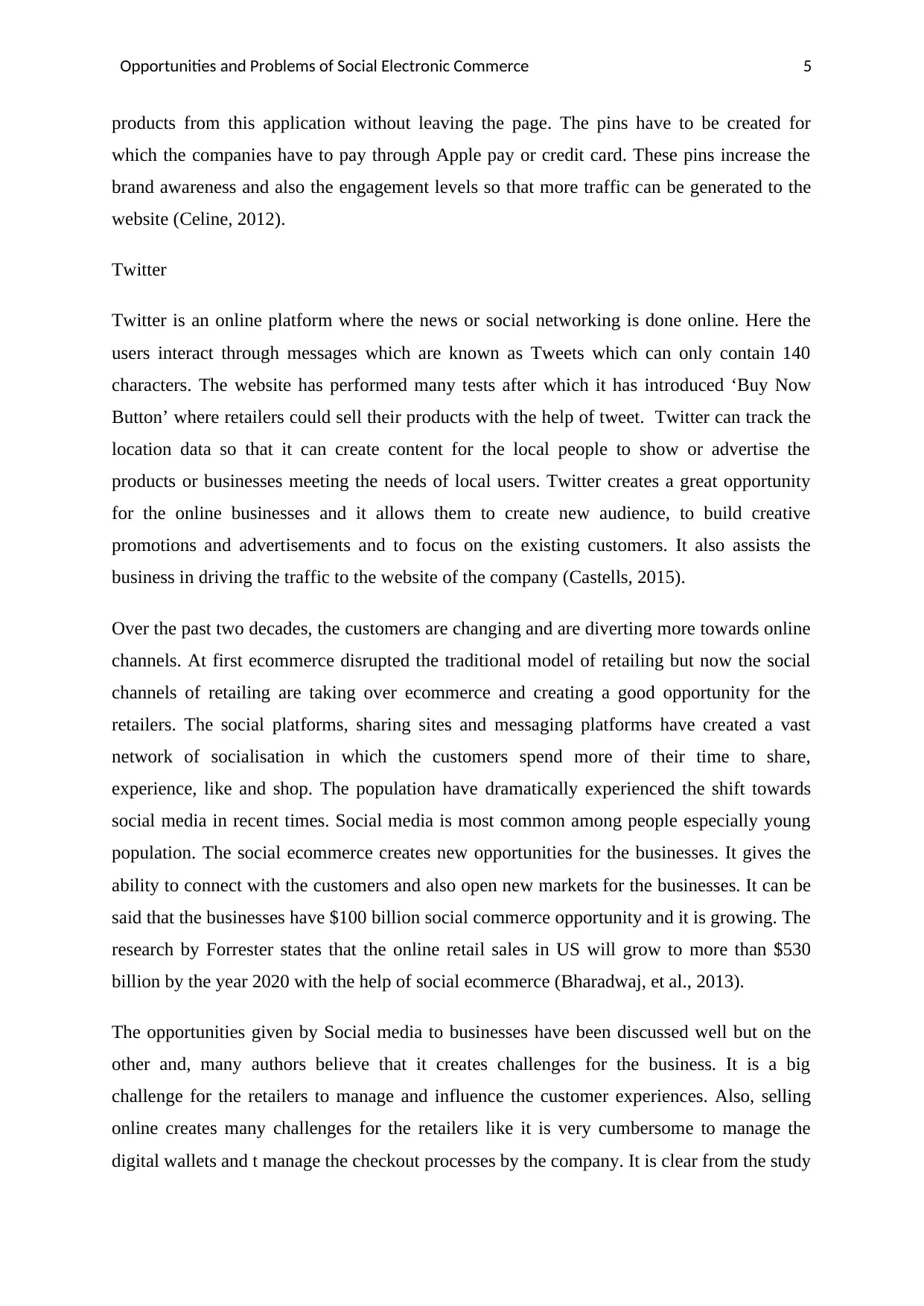
Opportunities and Problems of Social Electronic Commerce 5
products from this application without leaving the page. The pins have to be created for
which the companies have to pay through Apple pay or credit card. These pins increase the
brand awareness and also the engagement levels so that more traffic can be generated to the
website (Celine, 2012).
Twitter
Twitter is an online platform where the news or social networking is done online. Here the
users interact through messages which are known as Tweets which can only contain 140
characters. The website has performed many tests after which it has introduced ‘Buy Now
Button’ where retailers could sell their products with the help of tweet. Twitter can track the
location data so that it can create content for the local people to show or advertise the
products or businesses meeting the needs of local users. Twitter creates a great opportunity
for the online businesses and it allows them to create new audience, to build creative
promotions and advertisements and to focus on the existing customers. It also assists the
business in driving the traffic to the website of the company (Castells, 2015).
Over the past two decades, the customers are changing and are diverting more towards online
channels. At first ecommerce disrupted the traditional model of retailing but now the social
channels of retailing are taking over ecommerce and creating a good opportunity for the
retailers. The social platforms, sharing sites and messaging platforms have created a vast
network of socialisation in which the customers spend more of their time to share,
experience, like and shop. The population have dramatically experienced the shift towards
social media in recent times. Social media is most common among people especially young
population. The social ecommerce creates new opportunities for the businesses. It gives the
ability to connect with the customers and also open new markets for the businesses. It can be
said that the businesses have $100 billion social commerce opportunity and it is growing. The
research by Forrester states that the online retail sales in US will grow to more than $530
billion by the year 2020 with the help of social ecommerce (Bharadwaj, et al., 2013).
The opportunities given by Social media to businesses have been discussed well but on the
other and, many authors believe that it creates challenges for the business. It is a big
challenge for the retailers to manage and influence the customer experiences. Also, selling
online creates many challenges for the retailers like it is very cumbersome to manage the
digital wallets and t manage the checkout processes by the company. It is clear from the study
products from this application without leaving the page. The pins have to be created for
which the companies have to pay through Apple pay or credit card. These pins increase the
brand awareness and also the engagement levels so that more traffic can be generated to the
website (Celine, 2012).
Twitter is an online platform where the news or social networking is done online. Here the
users interact through messages which are known as Tweets which can only contain 140
characters. The website has performed many tests after which it has introduced ‘Buy Now
Button’ where retailers could sell their products with the help of tweet. Twitter can track the
location data so that it can create content for the local people to show or advertise the
products or businesses meeting the needs of local users. Twitter creates a great opportunity
for the online businesses and it allows them to create new audience, to build creative
promotions and advertisements and to focus on the existing customers. It also assists the
business in driving the traffic to the website of the company (Castells, 2015).
Over the past two decades, the customers are changing and are diverting more towards online
channels. At first ecommerce disrupted the traditional model of retailing but now the social
channels of retailing are taking over ecommerce and creating a good opportunity for the
retailers. The social platforms, sharing sites and messaging platforms have created a vast
network of socialisation in which the customers spend more of their time to share,
experience, like and shop. The population have dramatically experienced the shift towards
social media in recent times. Social media is most common among people especially young
population. The social ecommerce creates new opportunities for the businesses. It gives the
ability to connect with the customers and also open new markets for the businesses. It can be
said that the businesses have $100 billion social commerce opportunity and it is growing. The
research by Forrester states that the online retail sales in US will grow to more than $530
billion by the year 2020 with the help of social ecommerce (Bharadwaj, et al., 2013).
The opportunities given by Social media to businesses have been discussed well but on the
other and, many authors believe that it creates challenges for the business. It is a big
challenge for the retailers to manage and influence the customer experiences. Also, selling
online creates many challenges for the retailers like it is very cumbersome to manage the
digital wallets and t manage the checkout processes by the company. It is clear from the study
⊘ This is a preview!⊘
Do you want full access?
Subscribe today to unlock all pages.

Trusted by 1+ million students worldwide
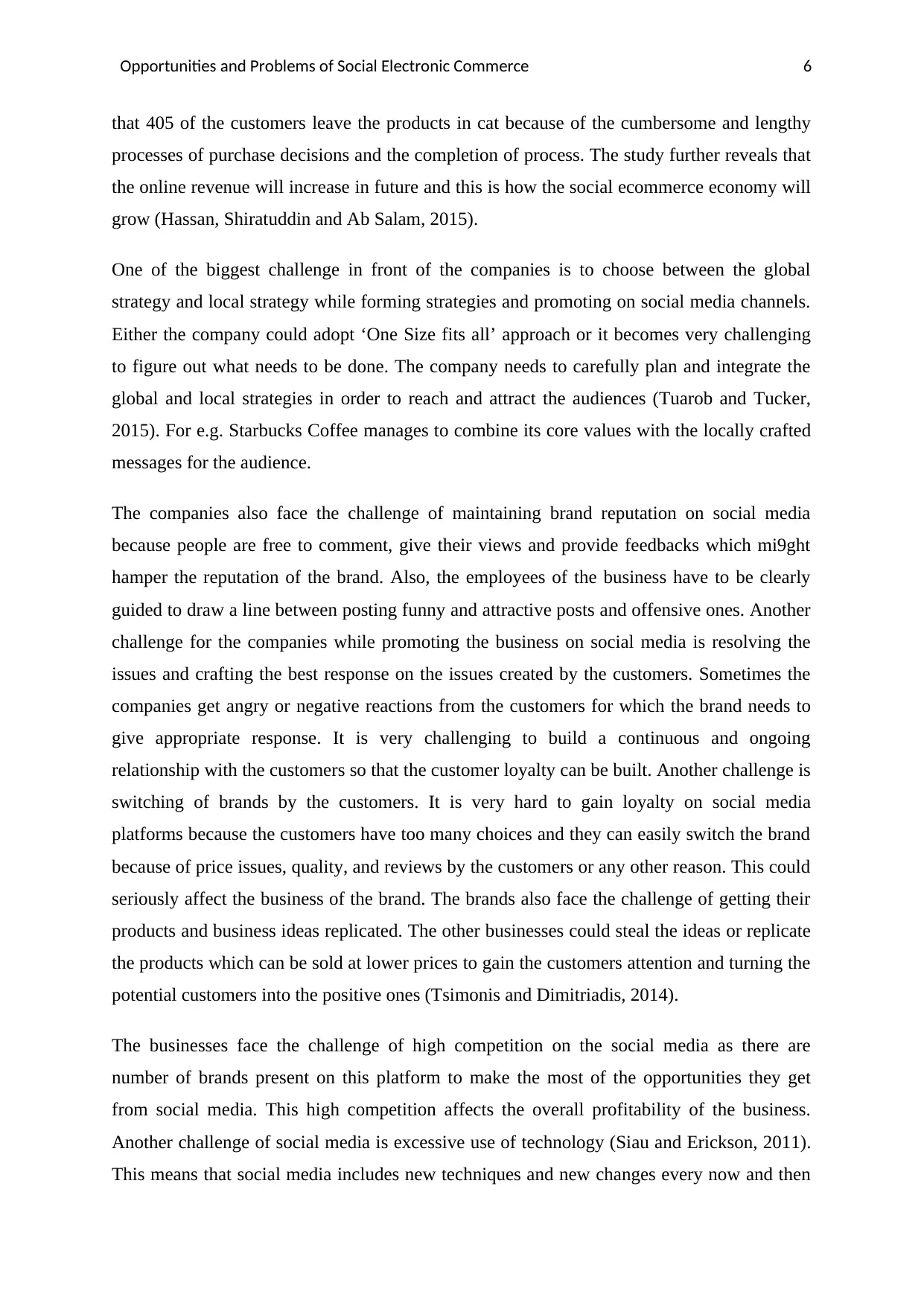
Opportunities and Problems of Social Electronic Commerce 6
that 405 of the customers leave the products in cat because of the cumbersome and lengthy
processes of purchase decisions and the completion of process. The study further reveals that
the online revenue will increase in future and this is how the social ecommerce economy will
grow (Hassan, Shiratuddin and Ab Salam, 2015).
One of the biggest challenge in front of the companies is to choose between the global
strategy and local strategy while forming strategies and promoting on social media channels.
Either the company could adopt ‘One Size fits all’ approach or it becomes very challenging
to figure out what needs to be done. The company needs to carefully plan and integrate the
global and local strategies in order to reach and attract the audiences (Tuarob and Tucker,
2015). For e.g. Starbucks Coffee manages to combine its core values with the locally crafted
messages for the audience.
The companies also face the challenge of maintaining brand reputation on social media
because people are free to comment, give their views and provide feedbacks which mi9ght
hamper the reputation of the brand. Also, the employees of the business have to be clearly
guided to draw a line between posting funny and attractive posts and offensive ones. Another
challenge for the companies while promoting the business on social media is resolving the
issues and crafting the best response on the issues created by the customers. Sometimes the
companies get angry or negative reactions from the customers for which the brand needs to
give appropriate response. It is very challenging to build a continuous and ongoing
relationship with the customers so that the customer loyalty can be built. Another challenge is
switching of brands by the customers. It is very hard to gain loyalty on social media
platforms because the customers have too many choices and they can easily switch the brand
because of price issues, quality, and reviews by the customers or any other reason. This could
seriously affect the business of the brand. The brands also face the challenge of getting their
products and business ideas replicated. The other businesses could steal the ideas or replicate
the products which can be sold at lower prices to gain the customers attention and turning the
potential customers into the positive ones (Tsimonis and Dimitriadis, 2014).
The businesses face the challenge of high competition on the social media as there are
number of brands present on this platform to make the most of the opportunities they get
from social media. This high competition affects the overall profitability of the business.
Another challenge of social media is excessive use of technology (Siau and Erickson, 2011).
This means that social media includes new techniques and new changes every now and then
that 405 of the customers leave the products in cat because of the cumbersome and lengthy
processes of purchase decisions and the completion of process. The study further reveals that
the online revenue will increase in future and this is how the social ecommerce economy will
grow (Hassan, Shiratuddin and Ab Salam, 2015).
One of the biggest challenge in front of the companies is to choose between the global
strategy and local strategy while forming strategies and promoting on social media channels.
Either the company could adopt ‘One Size fits all’ approach or it becomes very challenging
to figure out what needs to be done. The company needs to carefully plan and integrate the
global and local strategies in order to reach and attract the audiences (Tuarob and Tucker,
2015). For e.g. Starbucks Coffee manages to combine its core values with the locally crafted
messages for the audience.
The companies also face the challenge of maintaining brand reputation on social media
because people are free to comment, give their views and provide feedbacks which mi9ght
hamper the reputation of the brand. Also, the employees of the business have to be clearly
guided to draw a line between posting funny and attractive posts and offensive ones. Another
challenge for the companies while promoting the business on social media is resolving the
issues and crafting the best response on the issues created by the customers. Sometimes the
companies get angry or negative reactions from the customers for which the brand needs to
give appropriate response. It is very challenging to build a continuous and ongoing
relationship with the customers so that the customer loyalty can be built. Another challenge is
switching of brands by the customers. It is very hard to gain loyalty on social media
platforms because the customers have too many choices and they can easily switch the brand
because of price issues, quality, and reviews by the customers or any other reason. This could
seriously affect the business of the brand. The brands also face the challenge of getting their
products and business ideas replicated. The other businesses could steal the ideas or replicate
the products which can be sold at lower prices to gain the customers attention and turning the
potential customers into the positive ones (Tsimonis and Dimitriadis, 2014).
The businesses face the challenge of high competition on the social media as there are
number of brands present on this platform to make the most of the opportunities they get
from social media. This high competition affects the overall profitability of the business.
Another challenge of social media is excessive use of technology (Siau and Erickson, 2011).
This means that social media includes new techniques and new changes every now and then
Paraphrase This Document
Need a fresh take? Get an instant paraphrase of this document with our AI Paraphraser
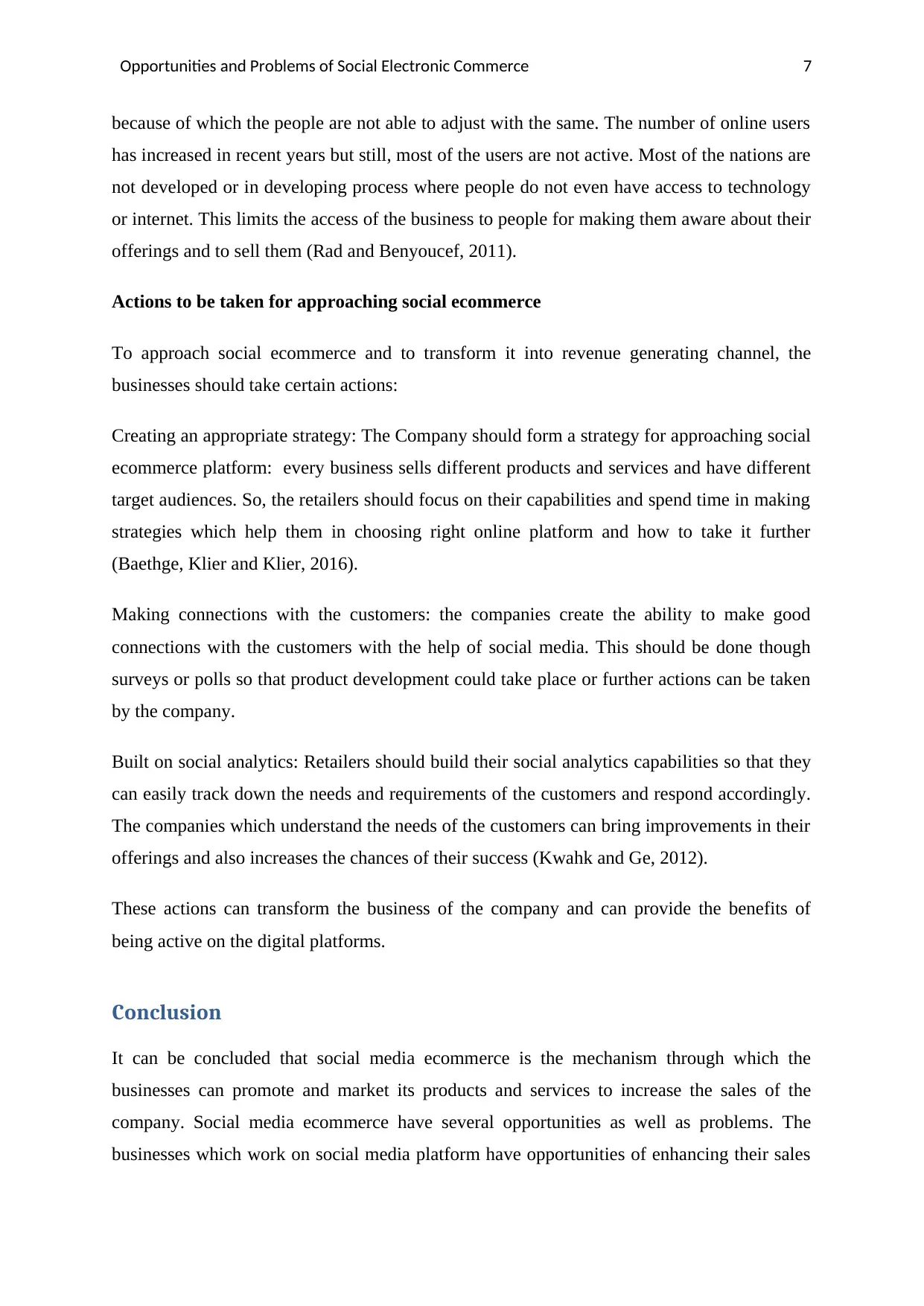
Opportunities and Problems of Social Electronic Commerce 7
because of which the people are not able to adjust with the same. The number of online users
has increased in recent years but still, most of the users are not active. Most of the nations are
not developed or in developing process where people do not even have access to technology
or internet. This limits the access of the business to people for making them aware about their
offerings and to sell them (Rad and Benyoucef, 2011).
Actions to be taken for approaching social ecommerce
To approach social ecommerce and to transform it into revenue generating channel, the
businesses should take certain actions:
Creating an appropriate strategy: The Company should form a strategy for approaching social
ecommerce platform: every business sells different products and services and have different
target audiences. So, the retailers should focus on their capabilities and spend time in making
strategies which help them in choosing right online platform and how to take it further
(Baethge, Klier and Klier, 2016).
Making connections with the customers: the companies create the ability to make good
connections with the customers with the help of social media. This should be done though
surveys or polls so that product development could take place or further actions can be taken
by the company.
Built on social analytics: Retailers should build their social analytics capabilities so that they
can easily track down the needs and requirements of the customers and respond accordingly.
The companies which understand the needs of the customers can bring improvements in their
offerings and also increases the chances of their success (Kwahk and Ge, 2012).
These actions can transform the business of the company and can provide the benefits of
being active on the digital platforms.
Conclusion
It can be concluded that social media ecommerce is the mechanism through which the
businesses can promote and market its products and services to increase the sales of the
company. Social media ecommerce have several opportunities as well as problems. The
businesses which work on social media platform have opportunities of enhancing their sales
because of which the people are not able to adjust with the same. The number of online users
has increased in recent years but still, most of the users are not active. Most of the nations are
not developed or in developing process where people do not even have access to technology
or internet. This limits the access of the business to people for making them aware about their
offerings and to sell them (Rad and Benyoucef, 2011).
Actions to be taken for approaching social ecommerce
To approach social ecommerce and to transform it into revenue generating channel, the
businesses should take certain actions:
Creating an appropriate strategy: The Company should form a strategy for approaching social
ecommerce platform: every business sells different products and services and have different
target audiences. So, the retailers should focus on their capabilities and spend time in making
strategies which help them in choosing right online platform and how to take it further
(Baethge, Klier and Klier, 2016).
Making connections with the customers: the companies create the ability to make good
connections with the customers with the help of social media. This should be done though
surveys or polls so that product development could take place or further actions can be taken
by the company.
Built on social analytics: Retailers should build their social analytics capabilities so that they
can easily track down the needs and requirements of the customers and respond accordingly.
The companies which understand the needs of the customers can bring improvements in their
offerings and also increases the chances of their success (Kwahk and Ge, 2012).
These actions can transform the business of the company and can provide the benefits of
being active on the digital platforms.
Conclusion
It can be concluded that social media ecommerce is the mechanism through which the
businesses can promote and market its products and services to increase the sales of the
company. Social media ecommerce have several opportunities as well as problems. The
businesses which work on social media platform have opportunities of enhancing their sales

Opportunities and Problems of Social Electronic Commerce 8
volume, expanding the markets and of innovating their products and services as per the
requirements of the customers. The problems of social ecommerce are that it can hamper the
reputation of the business and there can be the difference between the local and global
strategies of the business. It can also create high level competition for the businesses and the
other problem can be inactive users on internet. At last, the strategic actions are discussed
which can be taken while adopting ecommerce on social platforms. The companies should
create appropriate strategy before entering into social ecommerce and should built excellent
social analytics so that the company can run on the basis of needs and requirements of the
customers.
volume, expanding the markets and of innovating their products and services as per the
requirements of the customers. The problems of social ecommerce are that it can hamper the
reputation of the business and there can be the difference between the local and global
strategies of the business. It can also create high level competition for the businesses and the
other problem can be inactive users on internet. At last, the strategic actions are discussed
which can be taken while adopting ecommerce on social platforms. The companies should
create appropriate strategy before entering into social ecommerce and should built excellent
social analytics so that the company can run on the basis of needs and requirements of the
customers.
⊘ This is a preview!⊘
Do you want full access?
Subscribe today to unlock all pages.

Trusted by 1+ million students worldwide
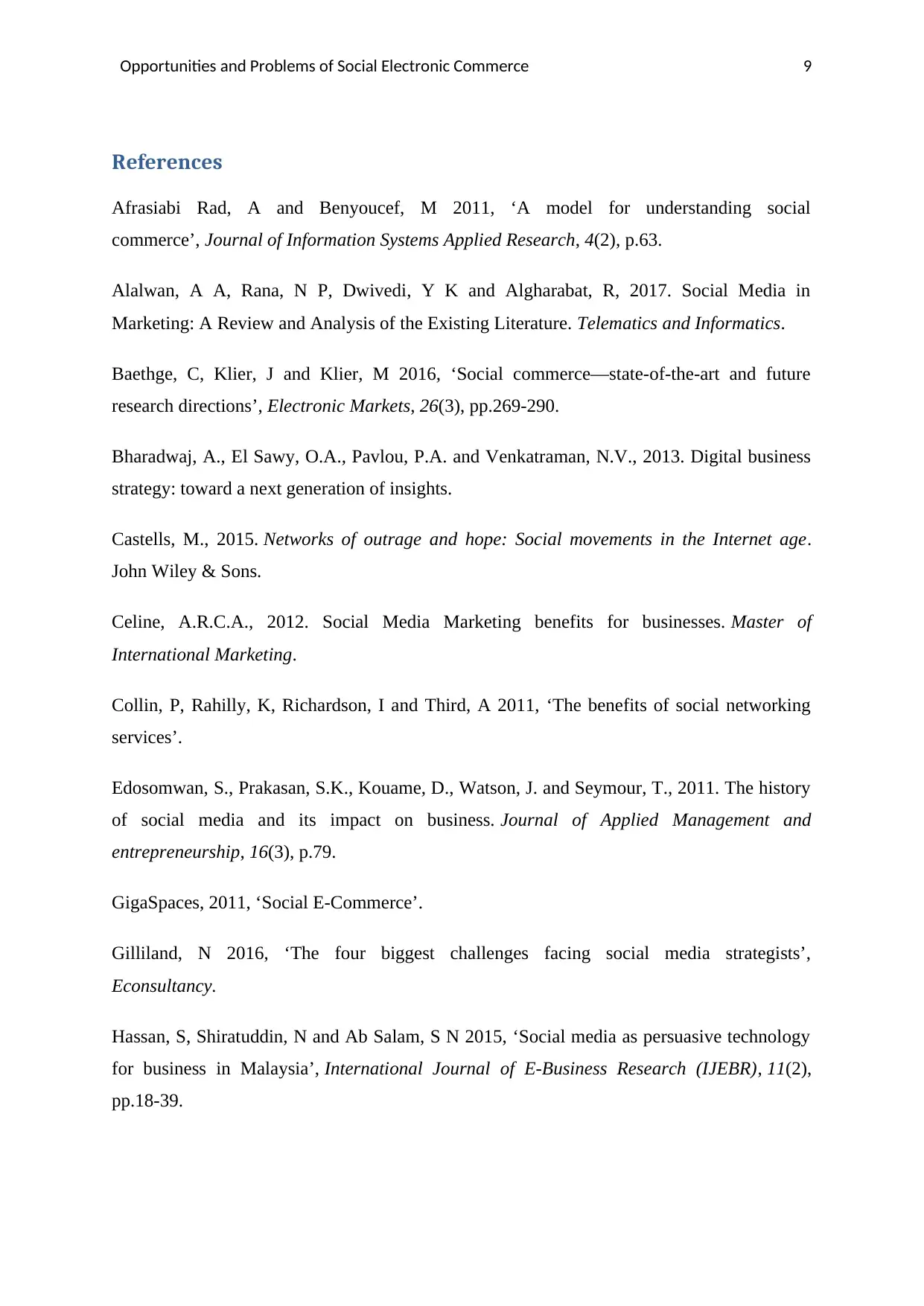
Opportunities and Problems of Social Electronic Commerce 9
References
Afrasiabi Rad, A and Benyoucef, M 2011, ‘A model for understanding social
commerce’, Journal of Information Systems Applied Research, 4(2), p.63.
Alalwan, A A, Rana, N P, Dwivedi, Y K and Algharabat, R, 2017. Social Media in
Marketing: A Review and Analysis of the Existing Literature. Telematics and Informatics.
Baethge, C, Klier, J and Klier, M 2016, ‘Social commerce—state-of-the-art and future
research directions’, Electronic Markets, 26(3), pp.269-290.
Bharadwaj, A., El Sawy, O.A., Pavlou, P.A. and Venkatraman, N.V., 2013. Digital business
strategy: toward a next generation of insights.
Castells, M., 2015. Networks of outrage and hope: Social movements in the Internet age.
John Wiley & Sons.
Celine, A.R.C.A., 2012. Social Media Marketing benefits for businesses. Master of
International Marketing.
Collin, P, Rahilly, K, Richardson, I and Third, A 2011, ‘The benefits of social networking
services’.
Edosomwan, S., Prakasan, S.K., Kouame, D., Watson, J. and Seymour, T., 2011. The history
of social media and its impact on business. Journal of Applied Management and
entrepreneurship, 16(3), p.79.
GigaSpaces, 2011, ‘Social E-Commerce’.
Gilliland, N 2016, ‘The four biggest challenges facing social media strategists’,
Econsultancy.
Hassan, S, Shiratuddin, N and Ab Salam, S N 2015, ‘Social media as persuasive technology
for business in Malaysia’, International Journal of E-Business Research (IJEBR), 11(2),
pp.18-39.
References
Afrasiabi Rad, A and Benyoucef, M 2011, ‘A model for understanding social
commerce’, Journal of Information Systems Applied Research, 4(2), p.63.
Alalwan, A A, Rana, N P, Dwivedi, Y K and Algharabat, R, 2017. Social Media in
Marketing: A Review and Analysis of the Existing Literature. Telematics and Informatics.
Baethge, C, Klier, J and Klier, M 2016, ‘Social commerce—state-of-the-art and future
research directions’, Electronic Markets, 26(3), pp.269-290.
Bharadwaj, A., El Sawy, O.A., Pavlou, P.A. and Venkatraman, N.V., 2013. Digital business
strategy: toward a next generation of insights.
Castells, M., 2015. Networks of outrage and hope: Social movements in the Internet age.
John Wiley & Sons.
Celine, A.R.C.A., 2012. Social Media Marketing benefits for businesses. Master of
International Marketing.
Collin, P, Rahilly, K, Richardson, I and Third, A 2011, ‘The benefits of social networking
services’.
Edosomwan, S., Prakasan, S.K., Kouame, D., Watson, J. and Seymour, T., 2011. The history
of social media and its impact on business. Journal of Applied Management and
entrepreneurship, 16(3), p.79.
GigaSpaces, 2011, ‘Social E-Commerce’.
Gilliland, N 2016, ‘The four biggest challenges facing social media strategists’,
Econsultancy.
Hassan, S, Shiratuddin, N and Ab Salam, S N 2015, ‘Social media as persuasive technology
for business in Malaysia’, International Journal of E-Business Research (IJEBR), 11(2),
pp.18-39.
Paraphrase This Document
Need a fresh take? Get an instant paraphrase of this document with our AI Paraphraser
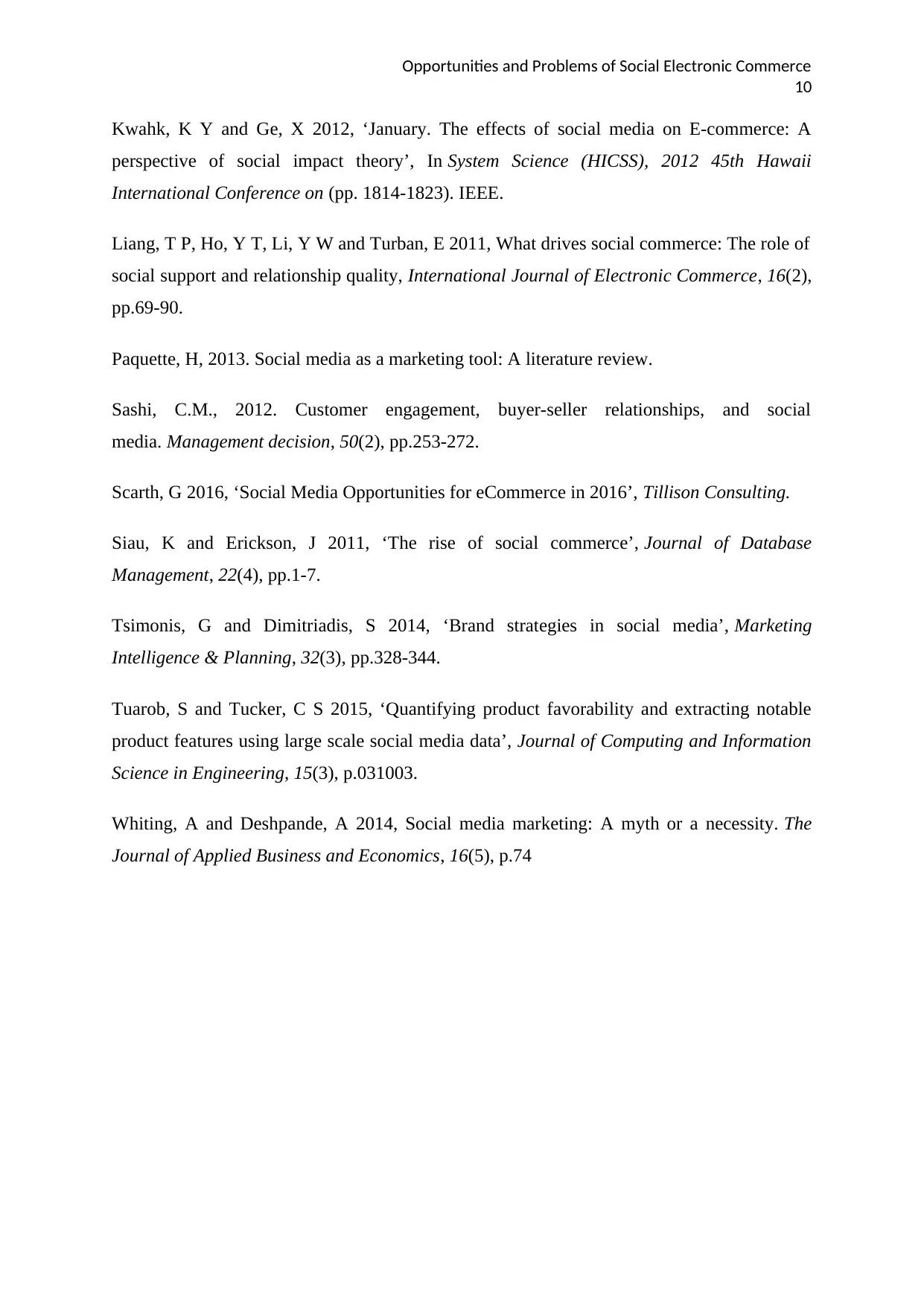
Opportunities and Problems of Social Electronic Commerce
10
Kwahk, K Y and Ge, X 2012, ‘January. The effects of social media on E-commerce: A
perspective of social impact theory’, In System Science (HICSS), 2012 45th Hawaii
International Conference on (pp. 1814-1823). IEEE.
Liang, T P, Ho, Y T, Li, Y W and Turban, E 2011, What drives social commerce: The role of
social support and relationship quality, International Journal of Electronic Commerce, 16(2),
pp.69-90.
Paquette, H, 2013. Social media as a marketing tool: A literature review.
Sashi, C.M., 2012. Customer engagement, buyer-seller relationships, and social
media. Management decision, 50(2), pp.253-272.
Scarth, G 2016, ‘Social Media Opportunities for eCommerce in 2016’, Tillison Consulting.
Siau, K and Erickson, J 2011, ‘The rise of social commerce’, Journal of Database
Management, 22(4), pp.1-7.
Tsimonis, G and Dimitriadis, S 2014, ‘Brand strategies in social media’, Marketing
Intelligence & Planning, 32(3), pp.328-344.
Tuarob, S and Tucker, C S 2015, ‘Quantifying product favorability and extracting notable
product features using large scale social media data’, Journal of Computing and Information
Science in Engineering, 15(3), p.031003.
Whiting, A and Deshpande, A 2014, Social media marketing: A myth or a necessity. The
Journal of Applied Business and Economics, 16(5), p.74
10
Kwahk, K Y and Ge, X 2012, ‘January. The effects of social media on E-commerce: A
perspective of social impact theory’, In System Science (HICSS), 2012 45th Hawaii
International Conference on (pp. 1814-1823). IEEE.
Liang, T P, Ho, Y T, Li, Y W and Turban, E 2011, What drives social commerce: The role of
social support and relationship quality, International Journal of Electronic Commerce, 16(2),
pp.69-90.
Paquette, H, 2013. Social media as a marketing tool: A literature review.
Sashi, C.M., 2012. Customer engagement, buyer-seller relationships, and social
media. Management decision, 50(2), pp.253-272.
Scarth, G 2016, ‘Social Media Opportunities for eCommerce in 2016’, Tillison Consulting.
Siau, K and Erickson, J 2011, ‘The rise of social commerce’, Journal of Database
Management, 22(4), pp.1-7.
Tsimonis, G and Dimitriadis, S 2014, ‘Brand strategies in social media’, Marketing
Intelligence & Planning, 32(3), pp.328-344.
Tuarob, S and Tucker, C S 2015, ‘Quantifying product favorability and extracting notable
product features using large scale social media data’, Journal of Computing and Information
Science in Engineering, 15(3), p.031003.
Whiting, A and Deshpande, A 2014, Social media marketing: A myth or a necessity. The
Journal of Applied Business and Economics, 16(5), p.74
1 out of 11
Related Documents
Your All-in-One AI-Powered Toolkit for Academic Success.
+13062052269
info@desklib.com
Available 24*7 on WhatsApp / Email
![[object Object]](/_next/static/media/star-bottom.7253800d.svg)
Unlock your academic potential
Copyright © 2020–2025 A2Z Services. All Rights Reserved. Developed and managed by ZUCOL.





